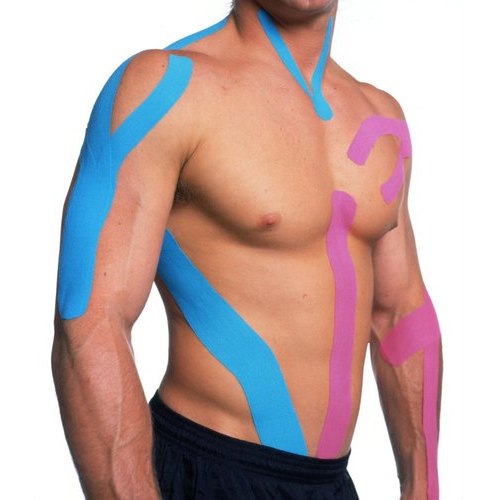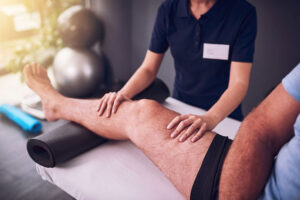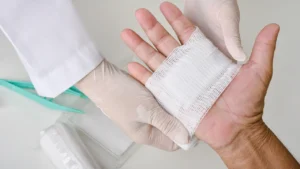Kinesio taping is a widely recognized therapeutic technique used by healthcare professionals to support muscles and joints while aiding in pain relief, improving circulation, and promoting lymphatic drainage. Unlike traditional athletic taping, which restricts movement, Kinesio taping provides functional support while allowing the body to move naturally. In this blog, we’ll explore how Kinesio taping works, its benefits, and how it can help with sports injuries, muscle strains, and rehabilitation therapy.
Introduction to Kinesio Taping
Kinesio taping is a therapeutic technique that utilizes an elastic therapeutic tape to support muscles and joints during physical activity. This innovative taping method is commonly used in physical therapy and sports medicine to aid recovery from injuries, prevent muscle fatigue, and reduce pain and inflammation.
What sets Kinesio tape apart from traditional athletic taping is its ability to enhance mobility and function without restricting the body’s natural movements. Unlike conventional taping methods, Kinesio taping helps correct abnormal muscle function, allowing for improved joint and muscle support during rehabilitation and sports recovery.
How Kinesio Taping Works
Kinesio tape is made of an elastic material that stretches up to 140% of its original length, mimicking the skin’s elasticity. When applied by a Doctor of Physical Therapy, Kinesio tape works to correct abnormal muscle function, improve blood flow, and enhance lymph drainage.
The tape creates a lifting effect on the skin, which helps reduce pressure on the underlying tissues. This lifting effect creates space between the skin and muscles, facilitating better fluid flow and reducing inflammation. As the lymphatic and circulatory systems function more effectively, pain and swelling are minimized, allowing for faster recovery and restored mobility.
Key Benefits of Kinesio Taping
Kinesio tape benefits go beyond simple muscle support. Here are some of the top advantages of Kinesio taping:
- Pain Relief: By alleviating muscle tension and reducing pressure on nerves, Kinesio tape provides effective pain relief, especially in areas with muscle strain or injury.
- Joint & Muscle Support: Kinesio taping offers functional support for muscles and joints, aiding in sports injury recovery without restricting natural movement. This makes it ideal for athletes who need support during rehabilitation.
- Inflammation Reduction: By promoting improved blood circulation and lymphatic drainage, Kinesio taping helps reduce swelling and inflammation around the injured area.
- Injury Prevention & Recovery: Regular use of Kinesio taping can assist in preventing future injuries and can enhance rehabilitation therapy by supporting muscles during the healing process.
Common Conditions Treated with Kinesio Taping
Kinesio taping is a versatile technique used to treat a wide range of conditions, including:
- Muscle Strains & Sprains: Kinesio taping helps support muscles during recovery, alleviating strain and preventing further damage.
- Joint Pain & Arthritis: The taping can relieve pressure on inflamed joints, providing relief from chronic pain.
- Tendonitis & Overuse Injuries: For those dealing with tendon inflammation or repetitive strain injuries, Kinesio taping helps support the tendons and reduce discomfort.
- Post-Surgical Rehabilitation: After surgery, Kinesio taping can be used to aid in recovery by reducing swelling and improving mobility.
- Lymphatic & Swelling Disorders: The lifting effect of Kinesio tape helps improve lymphatic drainage, reducing swelling and promoting fluid circulation.
Kinesio Taping vs. Traditional Taping
Unlike traditional athletic taping, which focuses on stabilizing joints and restricting movement to prevent injury, Kinesio taping is designed to support the body while still allowing for natural mobility. While traditional taping methods are often used for joint stabilization, Kinesio taping helps improve muscle function and promotes better fluid circulation without causing compression on the underlying tissues.
This unique approach allows for functional support that doesn’t interfere with the body’s natural movements, making it especially beneficial for athletes or individuals in rehabilitation.
How to Apply Kinesio Tape Correctly
Proper Kinesio taping techniques are essential for achieving the desired therapeutic results. The tape is applied with varying tension depending on the treatment area, whether it’s for pain relief, muscle support, or lymphatic drainage.
Here are some common application methods:
- For Muscle Support: The tape is applied with moderate tension to support muscles during movement.
- For Pain Relief: The tape is applied with lighter tension to help reduce discomfort in specific areas.
- For Swelling Reduction: The tape is strategically placed to lift the skin and promote better lymphatic flow.
While Kinesio taping can be applied at home, it’s highly recommended to seek guidance from a licensed physical therapist to ensure correct application for optimal results.
Who Can Benefit from Kinesio Taping?
Kinesio taping is beneficial for a wide range of individuals, including:
- Athletes & Fitness Enthusiasts: Whether recovering from an injury or trying to prevent one, Kinesio taping can provide support during physical activity.
- People Recovering from Injuries or Surgeries: Post-surgical rehabilitation and muscle recovery can be enhanced with Kinesio taping, reducing pain and improving mobility.
- Individuals with Chronic Pain or Joint Issues: Those suffering from conditions like arthritis or tendonitis can benefit from the pain-reducing and mobility-enhancing effects of Kinesio taping.
Takeaway
Kinesio taping is a powerful tool in pain relief, muscle support, and sports injury recovery. It works by improving circulation, reducing inflammation, and providing functional support to the muscles and joints. Whether you’re an athlete recovering from an injury, a fitness enthusiast looking to prevent muscle strain, or someone dealing with chronic joint pain, Kinesio taping offers a non-invasive solution to help you move better and recover faster.






